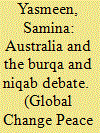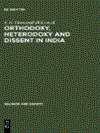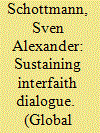|
|
|
Sort Order |
|
|
|
Items / Page
|
|
|
|
|
|
|
| Srl | Item |
| 1 |
ID:
125031


|
|
|
|
|
| Publication |
2013.
|
| Summary/Abstract |
This paper locates the discussion on wearing niqab and burqa within the context of information acquisition and response formation among Muslims and non-Muslims in the contemporary world. The paper argues that, against the backdrop of varied opinions on Islam and Muslims around the world, the debate on wearing burqa represents the continuation - albeit up-scaling - of the focus on Muslim women as the signifiers of Islam and Muslim identities. Australia is influenced by, and dealing with, the debate on whether or not to ban the burqa and niqab. Opinions among both the wider community and Muslims have differed on the justification and advisability of such a ban. The Australian government at the federal and state levels has demonstrated cautious activism in dealing with the issue, thus protecting the rights of Australian Muslim minorities, and reducing the space in which a heightened sense of exclusion could develop among them.
|
|
|
|
|
|
|
|
|
|
|
|
|
|
|
|
| 2 |
ID:
125040


|
|
|
|
|
| Publication |
2013.
|
| Summary/Abstract |
Despite its relative absence from much of the literature on politics in the Pacific region, religiosity is an assumed and often unchallenged component of political life. Drawing from more than 100 in-depth biographical interviews with politicians, around 40 published life histories and other publicly available material, this article uses Pierre Bourdieu's concept of 'habitus' to explore how politicians see the role of faith and religious association contributing to their public profile, election campaigning, representative and legislative functions, and 'inner' life. It advances two arguments: firstly, that ideal analytic distinctions like state, society and religion become problematic in the Pacific Islands where political leaders tend to occupy multiple roles and assume overlapping identities; and, secondly, that despite the overwhelming religiosity seemingly apparent in public rhetoric, secularization is an effervescent narrative across the region with politicians vocal protagonists on all sides of this debate.
|
|
|
|
|
|
|
|
|
|
|
|
|
|
|
|
| 3 |
ID:
077287


|
|
|
| 4 |
ID:
125055


|
|
|
|
|
| Publication |
2013.
|
| Summary/Abstract |
In this communications piece I want to try and capture some learnings from many years' work in this area of religious harmony. As a Church leader, I have generally had very demanding responsibilities; looking after large areas and numbers of people through our parishes, schools and welfare agencies. Accordingly, I am more a reflective activist than a scholar or academic. At the same time, I am convinced that the success of bringing religions into dialogue depends critically on broadening the base of those involved in these efforts. My commitment to the need for better religious harmony came when I was a University Chaplain at Monash University, Melbourne in the 1980s. Through the inspiration of the university's founders and various benefactors there was an Interreligious Centre, incorporating separate prayer rooms and chapels for different religions. There were sufficient 'religious' wars going on overseas then for us to appreciate how blessed we were to go to and from our Religious Centre in an uncomplicated way. On a Friday, I would be celebrating Holy Communion whilst Muslims were preparing for Friday prayers, Jews for the Sabbath. Incense from the Buddhist prayers would be in the air, along with our frankincense in the thurible. We would reflect that, in many parts of the world, such religious harmony would only invite a 'bomb'.
|
|
|
|
|
|
|
|
|
|
|
|
|
|
|
|
| 5 |
ID:
138953


|
|
|
|
|
| Publication |
Berlin, Mouton Publishers, 1984.
|
| Description |
v, 179p.Hbk
|
| Contents |
B
|
| Standard Number |
3110096595
|
|
|
|
|
|
|
|
|
|
|
|
Copies: C:1/I:0,R:0,Q:0
Circulation
| Accession# | Call# | Current Location | Status | Policy | Location |
| 058238 | 303.484/EIS 058238 | Main | On Shelf | General | |
|
|
|
|
| 6 |
ID:
125063


|
|
|
|
|
| Publication |
2013.
|
| Summary/Abstract |
Present-day Australia is often described as a successful example of a modern multicultural state. A growing number of non-British and non-European migrants have helped transform the country into an increasingly plural society. Intolerance and even outright racism persist in a few sectors, but on the whole, Australia's political, cultural and intellectual elites have accepted the need for migration, even if they have not always rushed to embrace the concept of multiculturalism. The most cursory of surveys of Australian cities, suburbs and even rural areas would readily reveal the extent to which the country has changed from the days of the 'white Australia' policy. Ethnic and cultural pluralism are just two measures of this new social pluralism; the growing diversity of religious expression is another very important dimension of Australia's multicultural reality. As Michális S. Michael points out, a key 'antidote to the politics of fear' has been the range of interfaith and multi-faith councils and networks that were set up in the course of the last 10 years. Some of these efforts were, in part at least, driven by what Joseph Camilleri describes as a 'narrow understanding of social cohesion' undertaken 'in the hope that dialogue would more effectively integrate [Muslims] into the mainstream'.3 They reflect still common views of Muslims as a 'problematic' minority prone to radicalization and the tendency to self-segregate. Nonetheless, these efforts of facilitating engagement across religious lines are a belated recognition of the social, economic and political significance of Australia's religious diversity, indeed of the enduring role religion plays in the modern, secular world.
|
|
|
|
|
|
|
|
|
|
|
|
|
|
|
|
|
|
|
|
|